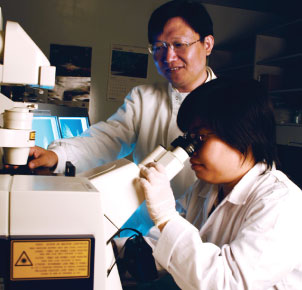
Prof Hanry Yu from the CSB programme
FRP Title: Tissues System Biology
Duration: July 2005 - June 2013
Principal Co-Investigators:
Singapore
Prof Hew Choy Leong (NUS), Prof Hanry Yu (NUS), Prof Ding Jeak Ling (NUS), Assoc Prof Lim Bing (GIS), Prof Lim Chwee Teck (NUS), Prof Gong Zhiyuan (NUS), Prof Colin Sheppard (NUS), Dr Lisa Tucker-Kellogg (NUS), Prof Paul T Matsudaira (NUS), Prof Jagath Rajapakse (NTU), Assoc Prof Sourav Saha Bhowmick (NTU)
MIT
Prof Peter So, Prof Chen Jianzhu, Prof Harvey F Lodish, Prof Subra Suresh, Prof Forbes Dewey
Research Objectives and Progress:
The CSB FRP studies the systems biology of tissues for the purpose of developing system-level genetic, proteomic and mechanical models that predict outcomes from perturbations caused by mutations, drugs and infectious agents. This FRP is structured along five sub-projects:
- Identification and characterisation of intestinal stem cells in the small intestine of zebrafish – The intestinal tract of the zebrafish resembles that of the mammalian species which serves as a model for studying human intestinal diseases. Through the research, researchers managed to develop a better understanding about the intestines of zebrafish. They aim further to identify the key molecules maintaining pluriplotency of stem cells through radiation studies on the intestines of zebrafish and the computational model developed to investigate the number of intestinal stem cells.
- Tissue systems biology for liver fribrosis – The team is working on a TGFß1 mediated switch between liver fibrosis and regression model, a quantification analysis of SHG/TPEF, a spatial model to study the propagation of fibrotic core to larger areas, and developing a high content method to classify and rank antibiotic compounds.
- Tissue defense against infection – While investigation in the aspect of host response to viral and bacterial infections in cell lines is still in progress, active investigation of lung tissue damage following influenza virus infection is being carried out concurrently.
- Experimental and computational nanomechanics and human diseases – The purpose of this research is to develop a comprehensive and quantitative understanding of the cellular and molecular level mechanics underlying two of the key pathogenic factors influencing the onset and progression of Plasmodium falciparum malaria, one of the most lethal diseases affecting global population.
- Stem cells – The team has made excellent progress in understanding the role of specific miRNA in regulating adipocyte differentiation and function. In addition, they have also profiled the miRNA expression patterns of white fat, brown fat and striated muscle. They have managed to identify three mRAN targets of this miRANA tentatively during erthropoiesis and are currently working on the association of its normal downregulation causing upregulation, as well as how these proteins then induce directly or indirectly.
Collaborating Research Institutes or Companies:
Genome Institute of Singapore (GIS), Institute of Medical Biology (IMB), Institute of Molecular and Cell Biology (IMCB)
